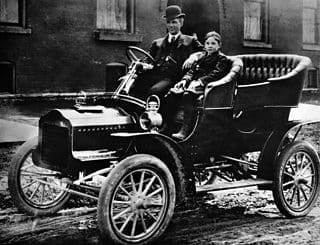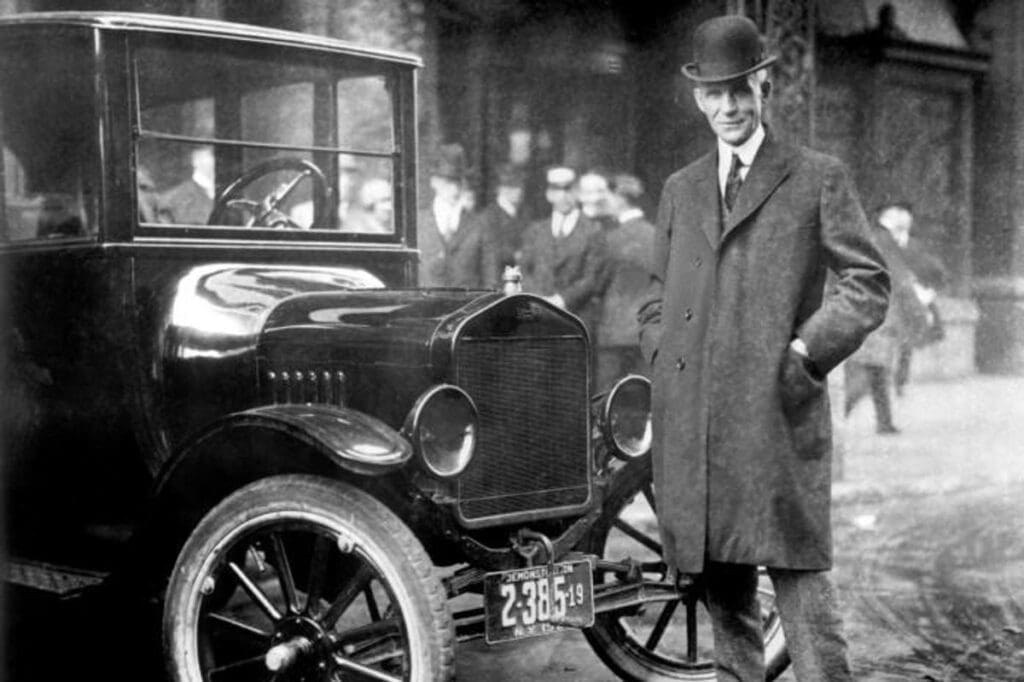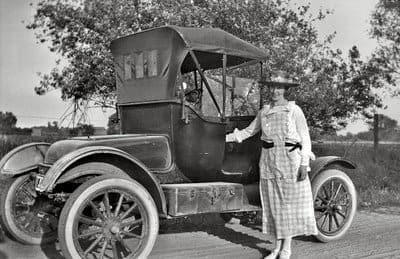Get ready to take a trip back in time to the Roaring Twenties, a decade that saw the birth of a cultural revolution in America. In this captivating article, we explore how one iconic invention, Ford’s Model T, single-handedly transformed the nation’s landscape and way of life. Buckle up and prepare to be amazed as we unveil the incredible impact of this groundbreaking automobile on the economy, society, and everyday lives of the American people.

This image is property of assets.editorial.aetnd.com.
The Introduction of the Model T
Revolutionizing the Automobile Industry
The introduction of Henry Ford’s Model T in 1908 revolutionized the automobile industry and transformed America in ways that were unprecedented. Prior to the Model T, cars were considered luxury items that only the wealthy could afford. However, with Ford’s innovative assembly line and mass production methods, the Model T became accessible to the average working-class American. This marked a pivotal shift in the automobile industry, as it made owning a car more attainable for the general population.
Affordability and Mass Production
One of the key reasons behind the success of the Model T was its affordability. Ford was determined to create a car that would be affordable for the average American, and he succeeded in doing so. By streamlining the production process and using standardized parts, Ford was able to bring down the cost of production significantly. As a result, the price of the Model T dropped from $825 in 1908 to just $360 by 1916, making it one of the most affordable cars on the market.
Furthermore, Ford’s implementation of the assembly line in the production process played a crucial role in making the Model T accessible to the masses. This revolutionary method allowed for efficient, continuous production, drastically reducing the time and cost required to build a car. The introduction of the assembly line not only increased productivity but also allowed Ford to meet the growing demand for the Model T.
Impact on Society
The widespread availability and affordability of the Model T had a profound impact on American society. The car became a symbol of freedom and independence, transforming the way people lived and interacted with their environment. With the ability to travel greater distances and explore new places, the Model T enabled Americans to venture beyond their immediate surroundings, contributing to a sense of exploration and adventure.
Additionally, the Model T brought about a significant shift in transportation and mobility. It reduced reliance on traditional modes of transportation such as horse-drawn carriages and trains, allowing people to travel at their own convenience. This newfound mobility stimulated economic growth, as individuals were now able to commute to work more easily and access leisure activities in distant locations. The Model T sparked a transportation revolution that laid the foundation for a modern, interconnected society.
The Rise of the Automotive Industry
The Birth of the Assembly Line
Ford’s introduction of the assembly line in automobile production revolutionized not only the manufacturing process but also the entire concept of mass production. The assembly line allowed for the division of labor, with each worker responsible for a specific task in the production process. This greatly increased efficiency and reduced costs, as specialized workers could perform their designated tasks more quickly and effectively.
Creating New Job Opportunities
The adoption of the assembly line not only transformed the manufacturing process but also created new job opportunities. The increased efficiency and lower production costs allowed automobile companies to scale up their operations and hire more workers. This led to the growth of the automotive industry and the creation of jobs that were previously non-existent. Workers who previously labored in agriculture or other industries now had the opportunity to work in the booming automotive sector.
Increase in Car Ownership
As the automotive industry flourished and the Model T became more affordable, car ownership saw a dramatic increase. Owning a car shifted from being a luxury reserved for the elite to becoming a common aspiration for many Americans. The increase in car ownership resulted in a shift in the way people traveled, worked, and socialized. It fostered a more interconnected society and laid the groundwork for the development of suburban areas, as individuals now had the means to commute longer distances.
Urbanization and the Model T
The Shift to Cities
The availability of the affordable Model T coincided with a significant shift in population from rural to urban areas. As job opportunities multiplied in cities, many Americans moved from rural communities to urban centers in search of work and better living conditions. The Model T played a significant role in facilitating this migration, as individuals could now commute to work in a more convenient and efficient manner.
The Impact on Urban Infrastructure
The rise of the Model T brought about a need for improved urban infrastructure. Cities had to adapt to accommodate the increased number of cars on the roads. Streets needed to be widened and improved, and parking spaces became a necessity. Additionally, the demand for gas stations, repair shops, and other automotive-related services increased, leading to the growth and development of urban areas. The Model T spurred the expansion and modernization of cities, creating the infrastructure required to support the growing automotive industry.
Effects on Transportation and Mobility
The Model T had a profound impact on transportation and mobility in urban areas. With the ability to travel greater distances, individuals were no longer limited to local amenities and services. They could easily access work, markets, and leisure activities in other parts of the city, contributing to the development of a more interconnected and vibrant urban culture. The Model T also fueled the growth of suburbs, as individuals could live outside of the city and commute to work using their cars.
The Model T and the Consumer Culture
The Birth of Consumerism
The Model T played a pivotal role in the birth of consumerism in America. With its mass production and affordability, it became a highly desirable product for the masses. Ford’s advertising and marketing strategies capitalized on this demand, creating a sense of aspiration and desire among consumers. The Model T became a symbol of success and status, and owning one became a statement of one’s place in society.
Advertising and Marketing Strategies
Ford was a visionary when it came to advertising and marketing. He recognized the importance of reaching out to a larger audience and created groundbreaking strategies to promote the Model T. Ford utilized print advertisements, billboards, and catalogs to market his cars. He also introduced innovative practices such as dealership systems and regional advertising campaigns. Ford’s effective marketing tactics created a sense of urgency and desire among consumers, driving sales and cementing the Model T’s position in popular culture.
The Rise of Automobile Culture
The widespread availability of the Model T fueled the rise of automobile culture in America. Car ownership became synonymous with freedom, adventure, and prestige. Americans took pride in their cars and developed a strong emotional attachment to them. The Model T inspired the creation of car clubs, road trips, and other social activities centered around automobiles. These trends not only contributed to the growth of the automotive industry but also fostered a sense of community and camaraderie among car enthusiasts.

This image is property of theoldshelter.com.
Shifts in Social Dynamics
Empowerment of Women
The Model T brought about a significant shift in social dynamics, especially for women. Prior to the advent of the automobile, women were confined to their domestic roles and had limited mobility. The Model T allowed women to venture outside their homes independently, granting them a newfound sense of freedom and independence. Women now had the ability to run errands, visit friends and family, and participate in social activities without being reliant on others. The car became a tool for empowerment, as it enabled women to break free from traditional gender norms and assert their autonomy.
Freedom and Independence
The Model T transformed the way people lived and interacted with their environment. In a society where personal mobility was previously limited, the car provided a newfound sense of freedom and independence. Individuals were no longer bound by schedules or restrictions imposed by public transportation. The Model T allowed Americans to travel on their own terms, explore new places, and make spontaneous decisions regarding their personal and professional lives. This sense of autonomy and individualism shaped the American identity and contributed to the notion of the “American Dream.”
Challenges to Traditional Gender Roles
The rise of the Model T and the empowerment it provided to women challenged traditional gender roles in American society. With greater mobility and independence, women had opportunities to participate in the workforce, engage in political activism, and pursue higher education. The Model T played a pivotal role in breaking down conventional gender barriers, as women were no longer confined to their homes and domestic duties. This shift in social dynamics was met with resistance and backlash from more conservative groups, but the impact of the Model T on gender equality was undeniable.
The Model T and the Prohibition Era
The Prohibition Movement
During the Prohibition era, when the production and sale of alcoholic beverages were banned, the Model T played a significant role in the illegal alcohol trade. Bootleggers and rum-runners used cars, including the Model T, to transport alcohol covertly from distilleries or foreign sources to speakeasies and other illicit establishments. The Model T’s reliability, speed, and affordability made it an ideal vehicle for such activities, and it became instrumental in circumventing the prohibition laws.
Use of Automobiles for Illegal Activities
The Model T’s association with the Prohibition era extended beyond its role in alcohol trafficking. The car itself became a tool for criminal organizations to carry out illegal activities such as robbery and kidnapping. Its speed and versatility made it an ideal getaway vehicle, allowing criminals to evade law enforcement. The Model T’s widespread availability and anonymity made it a popular choice among criminals during this tumultuous period in American history.
The Influence on Transportation and Distribution
The illicit use of the Model T during the Prohibition era had a significant impact on transportation and distribution. Law enforcement agencies had to adapt to the new challenges presented by the Model T, leading to improvements in surveillance and policing methods. Additionally, the need to crack down on illegal activities involving cars sparked advancements in forensic science and investigative techniques. The Model T became synonymous with both the positive and negative aspects of the Prohibition era, leaving a lasting impact on law enforcement and automotive culture.

This image is property of ichef.bbci.co.uk.
Advancements in Technology and Manufacturing
Innovations in Engine Technology
The Model T, and Ford in general, were at the forefront of advancements in engine technology. Ford introduced innovations such as the planetary transmission system, which allowed for smoother gear shifting. Additionally, the Model T featured a lightweight, durable engine that was both efficient and reliable. These advancements not only improved the driving experience but also set the stage for future developments in automotive engineering.
Impact on Other Industries
The success of the Model T had a ripple effect on other industries as well. The demand for automobiles created a boom in related sectors such as steel, rubber, and oil. The steel industry saw a surge in demand as more cars were produced, while rubber became a vital component for tires and other automotive parts. The need for gasoline to fuel the growing number of cars led to the expansion of the oil industry. These interdependent relationships between the automotive industry and other sectors contributed to economic growth and job creation.
The Evolution of Car Design
The Model T not only revolutionized the manufacturing process but also influenced the design of future cars. Its simple, utilitarian design set a precedent for the automotive industry, emphasizing functionality and affordability. The Model T laid the foundation for standardized car design, which focused on efficiency, practicality, and mass appeal. While later models introduced more elegance and sophistication, the legacy of the Model T’s design principles can still be seen in modern automobiles.
Implications for American Society and Economy
The Growth of the Middle Class
The introduction of the affordable Model T played a significant role in the growth of America’s middle class. As car ownership became more attainable, people were able to access jobs, markets, and social opportunities that were previously inaccessible. The Model T provided upward mobility for many Americans, enabling individuals to improve their quality of life and contribute to the economic growth of the country. The expansion of the middle class had profound implications for American society, shaping the values, aspirations, and expectations of a new generation.
The Expansion of the Travel and Tourism Industry
The Model T contributed to the expansion of the travel and tourism industry in America. With the ability to travel greater distances, Americans began to explore their own country. Road trips became a popular form of vacation, as families and friends set out on adventures to discover new destinations. This newfound mobility also sparked the development of roadside attractions, motels, and other businesses catering to the needs of travelers. The Model T played a pivotal role in transforming travel from a luxury to a widely accessible experience, fueling the growth of the tourism industry.
Changes in Transportation Infrastructure
The widespread adoption of the Model T necessitated changes in transportation infrastructure to accommodate the growing number of cars on the roads. Cities and towns had to adapt by constructing new roads, widening existing ones, and implementing traffic regulations. Additionally, the demand for services such as gas stations, repair shops, and parking facilities increased dramatically. The Model T revolutionized transportation infrastructure, laying the groundwork for a modern road network and influencing future urban planning.

This image is property of assets.rebelmouse.io.
The Model T and the Great Migration
Migration of African Americans
The Model T played a significant role in the Great Migration, the mass movement of African Americans from the rural South to urban areas in the North, Midwest, and West. The availability of affordable cars, such as the Model T, provided African Americans with the means to escape the oppressive segregation and discrimination of the Jim Crow South. Cars allowed them to travel long distances and access job opportunities in cities with greater ease than traditional modes of transportation.
Access to Better Job Opportunities
The Model T enabled African Americans to access better job opportunities in urban areas. With the ability to travel longer distances, individuals were no longer limited to the agricultural labor that dominated the rural South. They could now seek employment in industries such as manufacturing, construction, and services. The Model T was instrumental in facilitating the economic and social mobility of African Americans during the Great Migration.
Impacts on Racial Segregation
The widespread adoption of the Model T had both positive and negative impacts on racial segregation in America. On one hand, the Model T empowered African Americans by providing them with increased mobility and opportunities for economic advancement. On the other hand, racial segregation persisted in many urban areas, as African Americans faced discrimination and were restricted to certain neighborhoods and facilities. The Model T played a complex role in the fight for racial equality and the struggle against segregation, ultimately contributing to the ongoing civil rights movement.
Conclusion
The introduction of Ford’s Model T revolutionized the automotive industry and transformed American society beginning in the early 20th century. Its affordability, mass production methods, and marketing strategies made car ownership accessible to the average American, stimulating economic growth, and changing the way people lived, worked, and traveled. The Model T’s impact extended beyond transportation, shaping social dynamics, challenging gender roles, and influencing racial migration and segregation. The automobile became an integral part of American culture, symbolizing freedom, independence, and the pursuit of the American Dream. The Model T’s legacy lives on in modern car design and the interconnected world it helped create.

This image is property of marymiley.files.wordpress.com.


